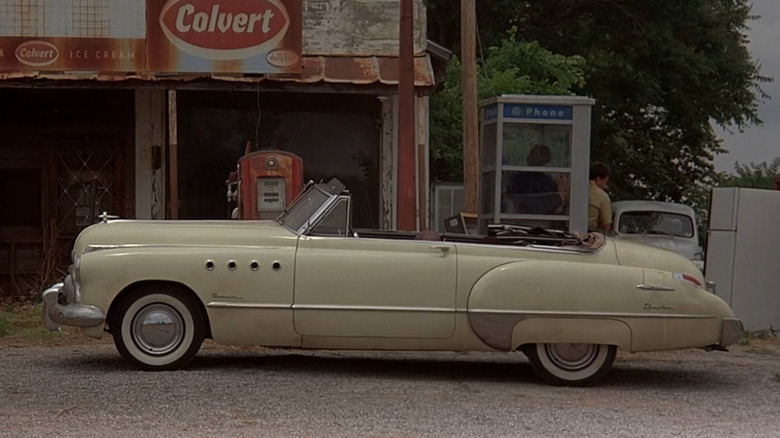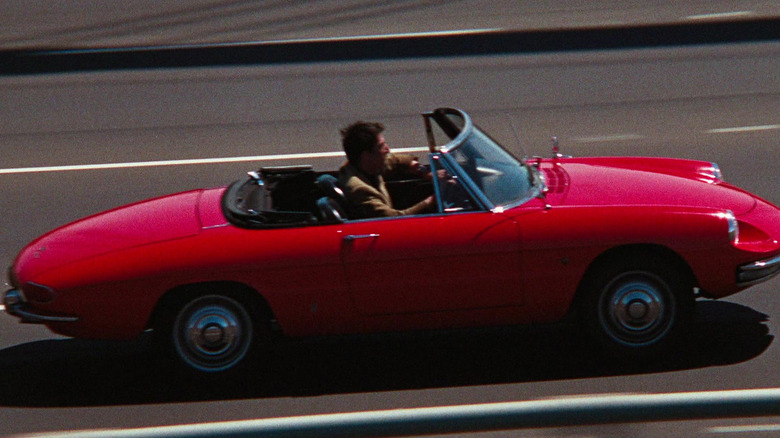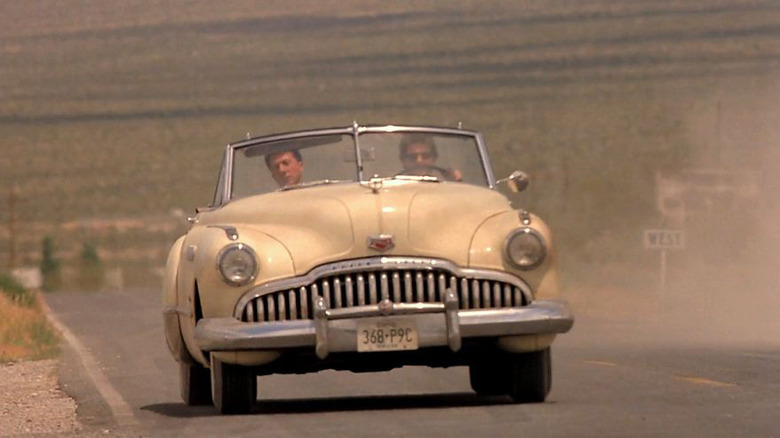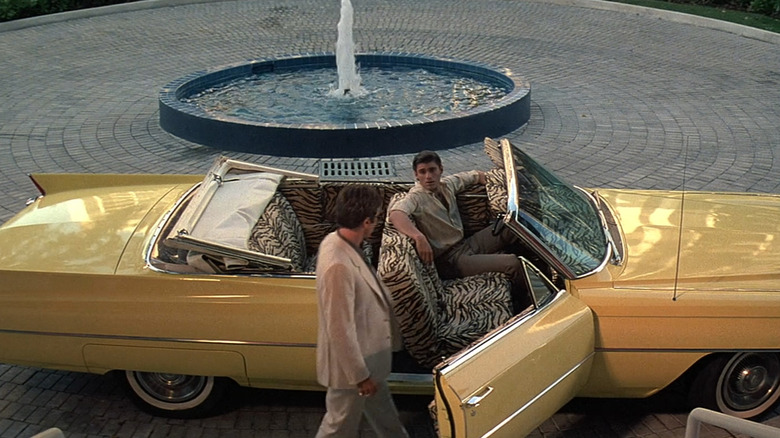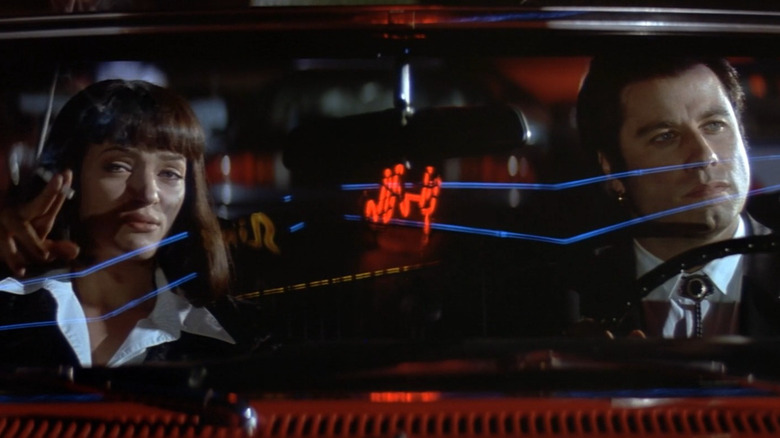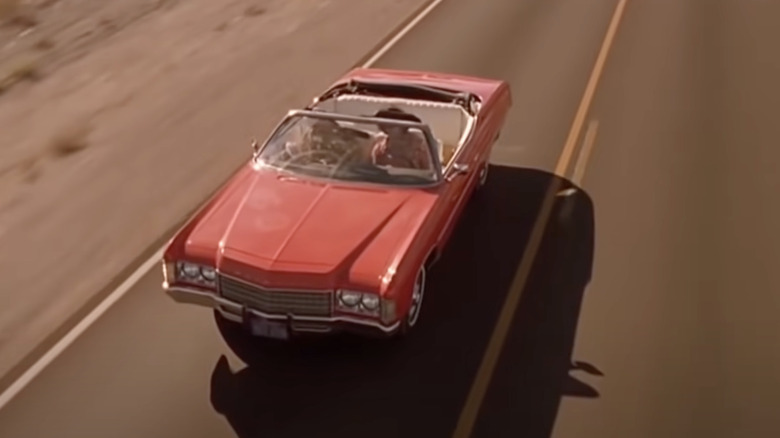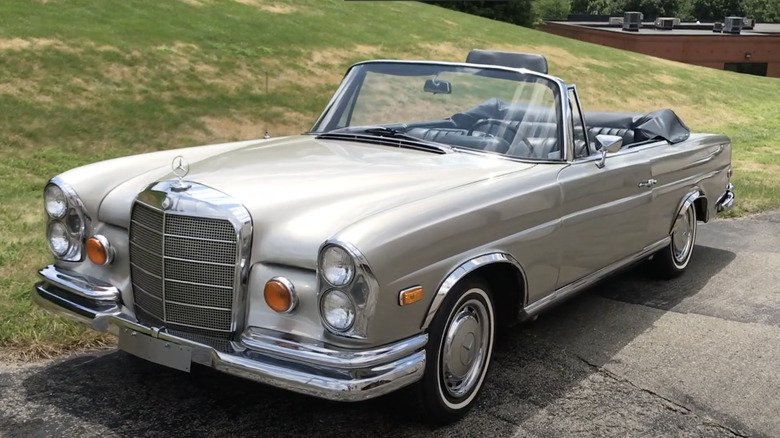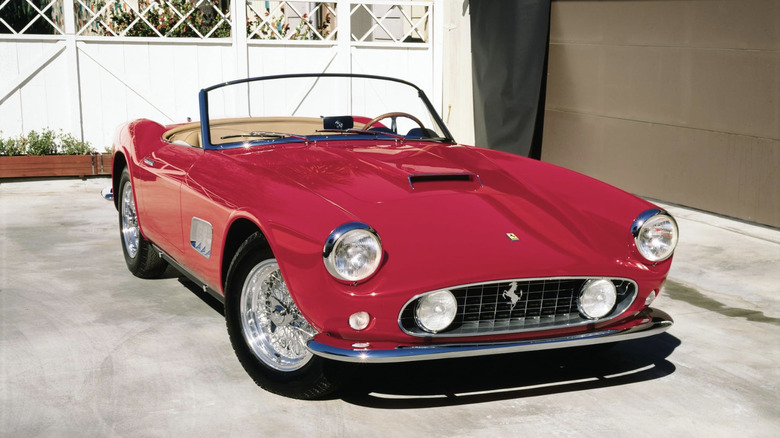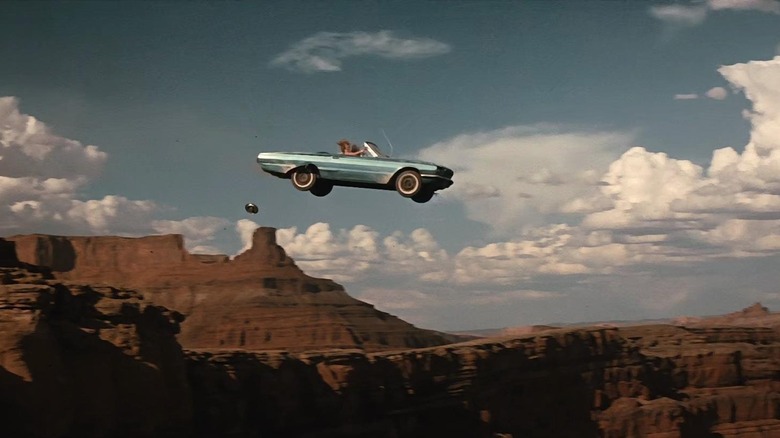8 Of The Most Unforgettable Movie Convertibles
We may receive a commission on purchases made from links.
American filmmakers have featured cars in movies since the heyday of the Ford Model T, which overlapped with the silent film era of the early 20th century. Car culture evolved throughout the 1900s, coinciding with the emergence of Hollywood as an artistic and economic powerhouse. Convertibles make ideal cars for movies, as it's much easier to see people riding in a car if the roof is tucked away behind the back seat. Plenty of early cars like the 1914 Chevy Royal Mail had foldaway canvas tops, but those were leaky, drafty disasters. Peugeot took a leap forward with the retractable roof on the 1934 601 Eclipse, and Plymouth introduced a motorized top in 1939.
American soldiers returning from World War II duty in Europe — where roadsters were common — helped boost demand for convertibles in the post-war years, and by the 1960s the trend had spread to the emerging muscle car segment.
Cars from this era and beyond often find their way onto the big screen, so let's take a look at some of the most notable convertibles to ever appear on film.
The Graduate featured a red Alfa Romeo convertible
The 1967 film "The Graduate" earned Mike Nichols an Oscar win for Best Director, along with a Best Picture nomination and additional nods for Dustin Hoffman, Anne Bancroft, and Katharine Ross for their acting performances. It was the first of seven Lead Actor nominations for Hoffman, who was making his film debut as recent college grad Benjamin Braddock. Bancroft starred as Mrs. Robinson, the wife of Ben's father's business partner, who draws the youngster into an affair. Ben later turns his romantic focus to her daughter Elaine (Ross), who is understandably put off when she learns of his dalliance with her mother.
Ben and Mrs. Robinson (her first name is never revealed in the movie) first connect romantically after escaping his graduation party together in his 1966 Alfa Romeo Duetto Spider, which was his graduation gift from his own parents. International trademark restrictions forced Alfa to rebadge the model as the Spider 1600 in the United States, and an Alfa might have been Nichols' choice because Hoffman's uncle imported them. The Duetto's $4,000 price tag was steep for the time, and the Spider Veloce 1750 replaced the Duetto the year after "The Graduate" came out. The car was so closely identified with the movie that in 1985, Alfa introduced the Spider Graduate, a bare-bones model that lived on through 1990.
Hoffman and Tom Cruise road-tripped in a 1949 Roadmaster in Rain Man
Hoffman is no stranger to on-screen convertibles, although in "Rain Man," he rode in the passenger seat. The automotive star of that 1988 Barry Levinson film was a 1949 Buick Roadmaster convertible that long-lost brothers Charlie and Ray Babbitt (Tom Cruise and Hoffman) take on a cross-country road trip after being reunited. The car belonged to their late father, who left it to Charlie despite (or perhaps because of) the fact that he took the car without his father's permission as a teenager. This decades-old stunt had landed Charlie in jail and caused a permanent rift in the family that he and Ray begin to mend.
"Rain Man" was an Oscar darling, winning Best Picture along with trophies for Hoffman as Best Lead Actor, Levinson as Best Director, and Ron Bass and Barry Morrow for Best Original Screenplay. The human cast was a little thin beyond its two stars; according to Bonham's, Levinson said the car had "third billing" behind Cruise and Hoffman. Hoffman took one of two Roadmasters used for filming after "Rain Man" wrapped, and Levinson bought the other. Hoffman put his up for sale in 2022 via the auction site, saying, "The Buick's been in storage too long. It should be driven, enjoyed, and cherished." It sold for $335,000, which is more than seven times the value that Hagerty cites for a good condition example.
Tony Montana owned a yellow 1963 Cadillac convertible in Scarface
The 1983 Brian DePalma classic "Scarface" starred Al Pacino as Tony Montana, a Cuban immigrant to the United States who builds a drug empire that quickly makes him a very rich and reckless man. He drives around Miami in a yellow 1963 Cadillac Series 62 convertible with tiger-print upholstery, a car Elvira Hancock (Michelle Pfeiffer) says, "looks like somebody's nightmare." It's one of many ways Elvira shows disdain for Tony before falling into his orbit and eventually marrying him.
The South Florida setting made "Scarface" an ideal platform for convertibles, and the film featured several other drop-tops in less prominent roles. Among them were a 1978 Mercury Monarch, a 1968 Chevy Impala, and a 1971 Chevy Nova. The Caddy is more than 18 and a half feet long with a wheelbase of 129.5 inches, making it a perfect ride for taller folks like Shaquille O'Neal, the 7'1" tall former NBA star who now owns the "Scarface" Cadillac.
The '64 Malibu from Pulp Fiction has a twisted history
There's plenty of fascinating lore surrounding the 1994 Quentin Tarantino crime flick "Pulp Fiction," but the wildest story isn't about John Travolta's casting or what's in Marcellus Wallace's briefcase. Rather, it's the tale of the 1964 Chevy Malibu driven by Travolta's character, Vincent Vega. Tarantino bought the Malibu from a friend after selling the script for "True Romance" in 1989, but the car sat in storage until "Pulp Fiction" went into production. That bit of truth found its way into the latter screenplay, with Vega mentioning to his drug dealer Lance (Eric Stoltz) that it had only been out of storage for three days before someone keyed it. Sometime during filming or shortly after the movie was released, someone went a step further in real life and stole the car.
Almost two decades later, in 2013, a San Bernardino County Sheriff's deputy happened upon a Malibu in Victorville and discovered that the Vehicle Identification Number (VIN) on the dash plate was matched to a different car registered in Oakland.
After poking around a bit, the deputy discovered the genuine VIN on the frame and identified Tarantino as the rightful owner. That was a shock to Bill Hemenez, who had bought the car in 2001 and spent more than $40,000 restoring it to pristine condition. The director got his car back, but reportedly did not offer Hemenez a token or word of gratitude for taking care of his baby for a dozen years.
The Chevy Caprice from Fear and Loathing in Las Vegas has a similar backstory
In 1998's "Fear and Loathing in Las Vegas," Johnny Depp plays Raoul Duke, a barely fictionalized version of journalist and author Hunter S. Thompson, who tears across the desert in a drug-induced haze/frenzy behind the wheel of a red 1973 Chevy Caprice convertible. The film was based on Thompson's book of the same name, and the car used in the film was his personal vehicle. Friends gave him the car in the early 1990s, about 20 years after a two-part series in Rolling Stone was expanded into the book that inspired the film.
Benicio del Toro co-starred in the movie as Doctor Gonzo, Duke's so-called "attorney" and a character based on Thompson's friend Oscar Zeta Acosta, a real-life lawyer who disappeared into the Pacific Ocean soon after the book was published and is the Caprice's driver for several portions of the film. Del Toro served as Executive Producer for the 2017 biographical documentary about Acosta called "The Rise and Fall of the Brown Buffalo" and starred Jesse Celedon as Acosta.
As for Thompson's Caprice, his widow Anita donated it to the Cannabition museum in Las Vegas after his death in 2005. She told Forbes, "One of my fondest memories is a drive we took to Thomasville [Colorado] in the summer in 2002. But, I'm happy to let people who love Hunter's work see it now and I'm thrilled to be a part of what Cannabition is doing."
Two different Mercedes models were used in The Hangover
Las Vegas has been the setting for many other cinematic tales of crime and debauchery, from "Leaving Las Vegas" to "Casino" and "Showgirls." A relatively recent example is the 2009 buddy comedy "The Hangover," which starred Bradley Cooper in his breakout performance alongside Ed Helms and Zach Galifianakis.
The mismatched trio are in Vegas for a bachelor party for their friend Doug (Justin Bartha), who goes missing during their first wild night. The Mercedes in "The Hangover" has a story as complicated as Tarantino's Malibu and Thompson's Caprice, although it doesn't center on a particular specimen. Several different cars were used in the filming of "The Hangover." Three were 280SE convertibles and two were 220SE coupes that were modified into convertibles. Filmmakers couldn't rely on just one example, given the beating the Mercedes takes throughout the film. This includes multiple collisions and interior damage inflicted by one of Mike Tyson's tigers.
Three of the five cars are reported to have made it to the end of the film intact, and one went up for sale in 2011 and again in 2013. The Mercedes did not reappear in 2011's The Hangover Part II or the third installment in 2013, although the last of the three saw an appearance by a silver Mercedes E350 convertible.
Ferrari lovers had their hearts broken on Ferris Bueller's Day Off
The 1986 comedy "Ferris Bueller's Day Off" helped cement John Hughes' legacy as perhaps the decade's most influential American filmmaker. It starred Matthew Broderick in the title role and Alan Ruck as his downtrodden best friend Cameron, who is dragged on a day of adventures around Chicago when the pair should be in school. Ferris coerces Cameron into taking the jaunt in Cameron's father's 1961 Ferrari 250 GT Spyder California convertible, a car Cameron says his dad loves "more than life itself."
The car miraculously survives their day in the city, but is wrecked when Cameron knocks it off a jack while they try to reverse the day's miles from the odometer. Fortunately for lovers of fine automobiles, the car that takes the climactic fall (as well as the others used in filming) were only recreations. Only 56 genuine 250 Spyder GTs were ever made, and one sold at auction in 2015 for over $18 million.
For the crash scene, a bit of cinematic magic was conjured up using a Jaguar, a Fiat, and a Volkswagen, but most of the shots in the film were of three replicas crafted by Modena Design, which made 50 of the knockoffs between 1987 and 1989. The imitation 250 GTs were powered by 289 cubic inch Ford V8s, and they were such good likenesses that Ferrari sued Modena to stop production. According to Maxim, one of the replicas used in the film sold last year for $313,000.
Thelma and Louise rode a 1966 Thunderbird convertible to their triumphant end
The 1991 road trip classic "Thelma and Louise" earned a handful of Oscar nods. Callie Khouri won for Best Original Screenplay, Susan Sarandon and Geena Davis were both nominated as Best Lead Actress, and the film also earned nominations and for cinematography and editing. The latter two came into play in the epic final scene, where the titular characters escape justice by driving Louise's 1966 Ford Thunderbird convertible off a cliff into the Grand Canyon.
The scene was actually shot at Dead Horse Point in Canyonlands National Park near Moab, Utah, and was the last sequence filmed. Producers prepped three T-bird coupes for the shot, chopping off the roofs and beefing up the frames. The first attempt was a dud, the second produced the epic shot seen in the final cut, and the third car was spared and lives on to this day. An intact "hero car" used to film earlier scenes went up for auction in 2008 and sold for $71,500. That's more than twice the $27,400 value Hagerty places on a 1966 T-bird ragtop in good condition, but the film car came with loads of memorabilia from the movie as well as the autographs of stars Davis and Brad Pitt on the interior.
